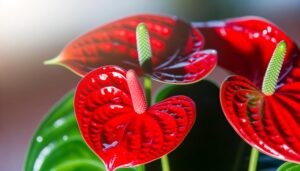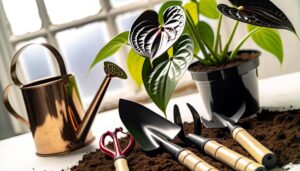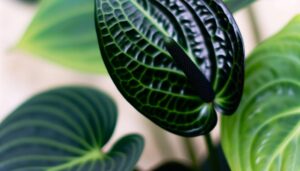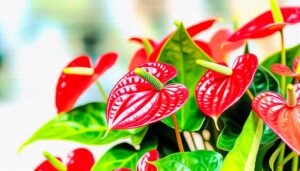Caring for Anthurium Red Stem Plants
Caring for Anthurium Red Stem plants requires attention to specific environmental conditions. Provide bright, indirect sunlight and avoid direct exposure to prevent leaf damage.
Use a well-draining potting mix composed of orchid bark, peat moss, and perlite. Water thoroughly when the top inch of soil is dry, ensuring consistent soil moisture and effective drainage.
Maintain humidity levels between 70% and 80% using a humidifier or a pebble-tray method. Fertilize every 6-8 weeks with a balanced, water-soluble fertilizer, diluted to half strength.
Regularly monitor for pests and diseases, and prune as necessary to sustain plant health. Learn about advanced techniques for best growth.
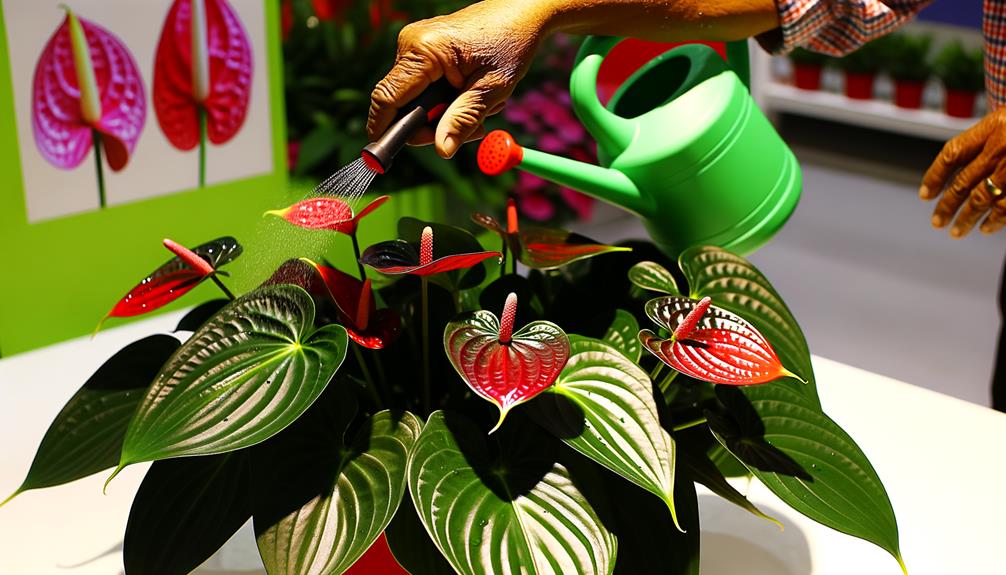
Key Takeaways
- Provide bright, indirect sunlight, avoiding direct exposure to prevent leaf scorch.
- Maintain soil moisture consistently, watering when the top inch of soil is dry.
- Use a well-draining potting mix with orchid bark, peat moss, and perlite.
- Keep humidity levels between 70% and 80%, using a humidifier if necessary.
- Fertilize every 6-8 weeks with a balanced, diluted 20-20-20 N-P-K fertilizer.
Ideal Light Conditions
Providing ideal light conditions for Anthurium Red Stem plants involves offering bright, indirect sunlight to support their photosynthetic needs while preventing leaf scorch. Position the plant near a north or east-facing window where it receives diffused light.
Avoid direct sunlight, which can cause photodamage, characterized by brown or bleached leaf margins. If natural light is insufficient, use artificial grow lights set to 10,000-20,000 lux to mimic the best light conditions.
Regularly rotate the plant to ensure even light exposure, promoting uniform growth. Monitor the foliage for signs of inadequate lighting, such as elongated stems and dull leaf coloration, and adjust the light source accordingly.
Watering Requirements
Proper hydration is essential for the health of Anthurium Red Stem plants, requiring the maintenance of consistent soil moisture levels.
It is vital to implement effective drainage techniques to prevent waterlogging, which can lead to root rot.
Utilize a well-draining potting mix and make sure that the container has sufficient drainage holes to facilitate ideal water flow.
Consistent Moisture Levels
Maintaining consistent moisture levels is essential for the best health of Anthurium Red Stem plants, as fluctuations can lead to root rot or dehydration. These tropical plants require a consistently moist but not waterlogged substrate. Utilize a well-draining potting mix and monitor soil moisture regularly, aiming for a consistently damp environment.
Employ a moisture meter to accurately gauge the soil's hydration status. Water the plant thoroughly when the top inch of the soil feels dry to the touch, ensuring uniform saturation. Avoid allowing the plant to sit in standing water, as this can exacerbate root rot.
Implementing a consistent watering schedule can help maintain ideal moisture levels, contributing to the robust growth and vibrant foliage of the Anthurium Red Stem plant.
Proper Drainage Techniques
To accomplish optimal hydration while preventing root rot, it is important to employ drainage techniques that facilitate excess water removal from the soil. Begin by using a well-draining potting mix, ideally composed of equal parts peat moss, pine bark, and perlite. This composition guarantees sufficient aeration and moisture retention.
Select pots with multiple drainage holes to allow water to escape freely. Additionally, placing a layer of gravel or small stones at the bottom of the pot further boosts drainage.
Monitor the watering schedule diligently; water the Anthurium Red Stem only when the top inch of the soil feels dry to the touch. Avoid waterlogging by emptying any surplus water collected in the saucer beneath the pot promptly.
Soil and Potting Mix
Anthurium red stem plants thrive in a well-draining potting mix that mimics their natural tropical habitat, typically composed of equal parts orchid bark, peat moss, and perlite. This composition guarantees optimal aeration and moisture retention, essential for the plant's root health.
Properly preparing the potting mix involves:
- Orchid Bark: This provides excellent drainage and aeration, preventing root rot.
- Peat Moss: It retains moisture and supplies necessary organic matter.
- Perlite: Enhances drainage and prevents soil compaction.
- Optional Additives: Add charcoal or coconut coir to further enhance substrate quality.
Guarantee the container has drainage holes to avoid waterlogging.
Regularly check the mix for compaction and replace it annually to maintain ideal growing conditions.
Humidity Needs
Ideal humidity levels are essential for the thriving growth of Anthurium red stem plants, ideally maintained between 70% and 80%. Consistent high humidity replicates their native tropical environments, preventing foliar desiccation and promoting optimum physiological functions.
Utilize a hygrometer to monitor ambient humidity precisely. If levels fall below the desired range, employ a humidifier to elevate moisture content effectively. Alternatively, place the pot on a tray filled with water and pebbles, ensuring the base does not contact water directly, to create a micro-humid environment.
Grouping plants can also enhance local humidity through collective transpiration. Regularly misting the foliage with distilled water can supplement ambient moisture, though care must be taken to avoid waterlogging and fungal proliferation.
Fertilizing Tips
Regular fertilization is essential to support the vigorous growth and vibrant foliage of Anthurium red stem plants. Employing a balanced, water-soluble fertilizer with an N-P-K ratio of 20-20-20 is recommended.
Here are detailed tips for best fertilization:
- Frequency: Apply fertilizer every 6-8 weeks during the growing season (spring through early fall).
- Dilution: Dilute the fertilizer to half the recommended strength to prevent root burn and nutrient toxicity.
- Application: Evenly distribute the diluted solution over the soil, ensuring it reaches the root zone without causing waterlogging.
- Monitoring: Observe plant response; yellowing leaves may indicate nutrient deficiency, necessitating adjustments to the fertilization regimen.
Adhering to these guidelines will promote robust growth and sustained plant health.
Pruning and Maintenance
Sustaining the health and aesthetics of Anthurium red stem plants necessitates precise pruning techniques to remove dead or damaged leaves and promote optimal growth.
Begin by sterilizing pruning shears with isopropyl alcohol to prevent pathogen transmission. Identify senescent or necrotic leaves, and make clean cuts at the base of the petiole, taking care not to harm the main stem.
Regularly inspect for yellowing foliage, which may indicate nutrient deficiencies or improper watering. Prune inflorescences post-bloom to channel energy into vegetative growth.
Conduct maintenance pruning bi-monthly, but avoid excessive cutting, which can stress the plant. By following these meticulous pruning protocols, you promote robust development, prolonged longevity, and a visually appealing Anthurium red stem specimen.
Pest and Disease Control
Effective pest and disease control for Anthurium red stem plants hinges upon early identification and targeted intervention strategies to mitigate infestations and infections. Key pathogens include fungal, bacterial, and viral agents, while common pests are aphids, mealybugs, and spider mites.
Employ the following techniques for ideal plant health:
- Regular Monitoring: Inspect plants weekly for signs of pests or disease. Look for discolored leaves, wilt, or abnormal growth.
- Sanitary Practices: Sterilize tools and remove dead or diseased plant material promptly to prevent pathogen spread.
- Biological Controls: Introduce natural predators such as ladybugs or beneficial nematodes to manage pest populations.
- Chemical Treatments: Apply fungicides and insecticides as needed, ensuring proper dosage and adherence to manufacturer guidelines.
These steps are essential for maintaining healthy Anthurium red stem plants.
Conclusion
In the symphony of botanical care, nurturing anthurium red stem plants requires harmonizing light conditions, precise hydration, ideal soil composition, and humidity calibration.
Fertilization, coupled with meticulous pruning, maximizes growth while vigilant pest and disease control safeguards plant health.
Mastery of these elements orchestrates a thriving anthurium, with each factor playing a pivotal role in the lush, vibrant performance of this tropical species.
Such disciplined horticultural practice fosters a flourishing, verdant environment.

